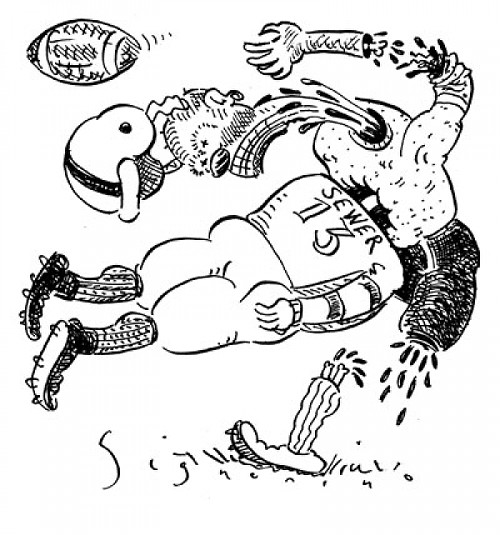A rugby player friend of mine says one reason for the serious injuries in American football is pads and helmets. He says players can hit harder because of protective equipment and do so knowing they will suffer less injury than those on the receiving end. Also, he claims that if players went back to one-platoon football, meaning they played both offense and defense, the size of the players on offense and defense would be smaller and more equal and there would be less chance of a big, fast linebacker laying flat a receiver or quarterback. Any truth to either of these lines of thought, or is it just rugby snobbery? —Sam Johnson
It’s partly rugby snobbery, but nevermind. Is it true? Probably yes.
The concept here is called risk homeostasis or risk compensation. It holds that everyone engaged in a dangerous activity has a personal risk vs. reward level they’ll stick to no matter what. In other words, if you force someone playing a contact sport to wear protective equipment, they’ll take bigger risks to bring the overall danger back to the level they’re comfortable with.
Does that sound self-destructive? If only. When risky behavior increases, others may bear the brunt. A watershed 1975 study of automobile-safety measures theorized that motorists increased their driving “intensity” if they felt safer behind the wheel, leading to fewer driver and passenger deaths but more dead pedestrians.
Applying this theory to football, one might suppose that as players switched from simple leather helmets to today’s elaborate headgear, they’d hit harder, use their heads more and, generally, play more recklessly. In fact, that seems to have been what happened.
When hard plastic football helmets became popular after World War II, tackling methods shifted, so that by the early ’60s, players had gone from tackling shoulder first to head first. Possibly as a result, tackling injuries in the years from 1955 through 1964 rose significantly compared to a decade earlier. This eventually led to rule changes, notably a ban on “spearing” (hits delivered via a lowered head), and better standards for helmets.
To be clear, helmets do work—up to a point. Experiments have shown, for example, that a helmet reduces the impact of heading a soccer ball traveling at 35 mph from 19 g to 8 g. But protecting against obvious dangers often just makes the problems more insidious. While helmets reduce skull fractures and deaths, they also encourage players to endure frequent concussions that, over a career, add up to brain damage.
Risk compensation isn’t limited to football. Examples from other sports:
A study of little leaguers found kids using soft rather than standard baseballs suffered more injuries, probably due to taking bigger fielding risks and being less afraid of wild pitches.
Researchers found rugby players who wore helmets tackled harder than those without.
The use of quick-release bindings and helmets by skiers and snowboarders may have led to more risk-taking and associated casualties.
Risk compensation may not apply to all sports, though:
Before masks and pierce-resistant jackets, fencing was infamous for blindings, other serious injuries and death, even when using blunted foils. After protective gear became mandatory, injury and death rates plummeted, and the sport has seen only seven fatalities in international competition since 1937.
Studies have found hockey players wearing only upper-face protection get injured more than those wearing full face masks, and also more likely to engage in illegal behavior.
Helmet-wearing bicyclists not only suffer fewer serious injuries but also use hand signals more and obey the rules of the road.
On closer examination, though, the last two cases may not be exceptions after all. Bike helmets are generally optional equipment (for adults at least), and anyone who wears protective headgear without being compelled to is by definition a cautious sort. Likewise, you have to wonder if differences among hockey players can be attributed to more aggressive types who, given the choice, pick headgear that offers less protection.
A concept related to risk compensation is moral hazard, where people do dangerous things because they won’t suffer the consequences. One much-studied question is why American League batters have gotten hit by pitches 15 percent more often than their National League counterparts since imposition of the designated hitter rule. For many, the explanation is obvious: Since AL pitchers don’t bat, a beanball thrower doesn’t risk retaliation. But some researchers say an equally important factor is that DHs are much better hitters than the pitchers they replace and thus likelier targets for brushbacks and beanings.
Finally, would going back to one-platoon football would make the game safer? There’s virtually no data. On the one hand, it seems obvious that if the same squad had to play both ways, no team could afford 300-pound linemen. Then again, linebacker Lawrence Taylor, whose brutal quarterback sacks famously gave rise to the 300-pound blind-side offensive tackle, was a relative lightweight at 240 pounds. So I’m not convinced a no-sub rule would give us a kinder, gentler game.
Send questions to Cecil via StraightDope.com or write him c/o Chicago Reader, 350 N. Orleans, Chicago 60654. Subscribe to the Straight Dope podcast at the iTunes.
More by Cecil Adams
-
This Is the End, My Friend
This week's Straight Dope marks the last appearance of the column as the Teeming Millions have known it for the past 45 years.
- Jul 11, 2018
-
Do Brain Supplements Do Anything?
Brain Drain
- Jul 4, 2018
-
Is flying really worse for the environment than driving?
Planes and Trains
- Jun 27, 2018
- More »




